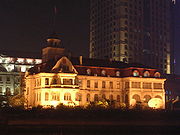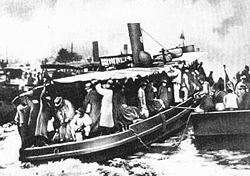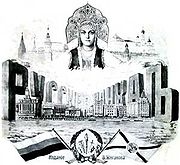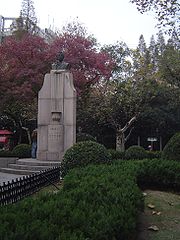
Shanghai Russians
Encyclopedia

Russian diaspora
The term Russian diaspora refers to the global community of ethnic Russians, usually more specifically those who maintain some kind of connection, even if ephemeral, to the land of their ancestors and maintain their feeling of Russian national identity within a local community.The term "Russian...
that flourished in Shanghai
Shanghai
Shanghai is the largest city by population in China and the largest city proper in the world. It is one of the four province-level municipalities in the People's Republic of China, with a total population of over 23 million as of 2010...
, China
China
Chinese civilization may refer to:* China for more general discussion of the country.* Chinese culture* Greater China, the transnational community of ethnic Chinese.* History of China* Sinosphere, the area historically affected by Chinese culture...
between the World Wars. By 1937 it is estimated that there were as many as 25,000 anti-Bolshevik
Bolshevik
The Bolsheviks, originally also Bolshevists , derived from bol'shinstvo, "majority") were a faction of the Marxist Russian Social Democratic Labour Party which split apart from the Menshevik faction at the Second Party Congress in 1903....
Russians living in the city, the largest European group by far. Most of them had come from the Russian Far East
Russian Far East
Russian Far East is a term that refers to the Russian part of the Far East, i.e., extreme east parts of Russia, between Lake Baikal in Eastern Siberia and the Pacific Ocean...
, where, with the support of the Japanese
Siberian Intervention
The ', or the Siberian Expedition, of 1918–1922 was the dispatch of troops of the Entente powers to the Russian Maritime Provinces as part of a larger effort by the western powers and Japan to support White Russian forces against the Bolshevik Red Army during the Russian Civil War...
, the Whites
White movement
The White movement and its military arm the White Army - known as the White Guard or the Whites - was a loose confederation of Anti-Communist forces.The movement comprised one of the politico-military Russian forces who fought...
had maintained a presence as late as the autumn of 1922.
Background
In the late 19th century, the Russian imperial government was shifting the focus of its investment to ManchuriaManchuria
Manchuria is a historical name given to a large geographic region in northeast Asia. Depending on the definition of its extent, Manchuria usually falls entirely within the People's Republic of China, or is sometimes divided between China and Russia. The region is commonly referred to as Northeast...
. As a consequence, China's trade with its northern neighbour soared. As soon as there was a regular ferry service between Vladivostok
Vladivostok
The city is located in the southern extremity of Muravyov-Amursky Peninsula, which is about 30 km long and approximately 12 km wide.The highest point is Mount Kholodilnik, the height of which is 257 m...
and Shanghai, the Russian tea merchants started to settle in the commercial capital of China. About 350 Russian citizens resided within the Shanghai International Settlement
Shanghai International Settlement
The Shanghai International Settlement began originally as a purely British settlement. It was one of the original five treaty ports which were established under the terms of the Treaty of Nanking at the end of the first opium war in the year 1842...
in 1905. In order to protect their interests, the Russian consulate
Consulate-General of Russia in Shanghai
The Consulate-General of the Russian Federation in Shanghai is the diplomatic mission of Russia in Shanghai. It is located at 20 Huangpu Road on The Bund in Shanghai, next to the Garden Bridge near the convergence of the Suzhou and Huangpu rivers, and across the road from the Astor House Hotel...
was opened in 1896. The old building of the consulate, still occupied by the Russian diplomats, ranks among the Bund
The Bund
The Bund is a waterfront area in central Shanghai, People's Republic of China. The area centres on a section of Zhongshan Road within the former Shanghai International Settlement, which runs along the western bank of the Huangpu River, facing Pudong, in the eastern part of Huangpu District...
's minor landmarks.
The bulk of the Russian exile community relocated to Shanghai from Vladivostok following the fall of the Provisional Priamurye Government
Provisional Priamurye Government
The Provisional Priamurye Government existed in the Siberian region of Priamurye, Russia, between May 27, 1921 and October 25, 1922...
at the close of the Russian Civil War
Russian Civil War
The Russian Civil War was a multi-party war that occurred within the former Russian Empire after the Russian provisional government collapsed to the Soviets, under the domination of the Bolshevik party. Soviet forces first assumed power in Petrograd The Russian Civil War (1917–1923) was a...
. Admiral Stark's squadron alone brought several thousand White Russians
White Emigre
A white émigré was a Russian who emigrated from Russia in the wake of the Russian Revolution and Russian Civil War, and who was in opposition to the contemporary Russian political climate....
from Vladivostok in 1922. Many Harbin Russians
Harbin Russians
The term Harbin Russians or Russian Harbinites refers to several generations of Russians who lived in the city of Harbin, a major junction city on the Chinese Eastern Railway , from approximately 1898 to the mid-1960s....
, attracted by the booming economy of Shanghai, moved from Manchuria to the coast over the following years. Barred by both distance and money from joining established communities in Paris
Paris
Paris is the capital and largest city in France, situated on the river Seine, in northern France, at the heart of the Île-de-France region...
and Berlin
Berlin
Berlin is the capital city of Germany and is one of the 16 states of Germany. With a population of 3.45 million people, Berlin is Germany's largest city. It is the second most populous city proper and the seventh most populous urban area in the European Union...
, a large number gravitated towards Shanghai, a freeport at the time, requiring no visa or work-permit for entry. For this same reason it was later to become a refuge for Jews fleeing the Nazis.

Living conditions
Although free, and relatively secure, conditions for the émigrés were far from ideal. For one thing they were all stateless, as the Soviet government had revoked the citizenship of all political exiles in 1921. The only travel document most of them had was the Nansen passportNansen passport
Nansen passports were internationally recognized identity cards first issued by the League of Nations to stateless refugees.-Origins:Designed in 1921 by Fridtjof Nansen, in 1942 they were honored by governments in 52 countries and were the first refugee travel documents...
, issued by the League of Nations
League of Nations
The League of Nations was an intergovernmental organization founded as a result of the Paris Peace Conference that ended the First World War. It was the first permanent international organization whose principal mission was to maintain world peace...
. Unlike other foreigners in China
China
Chinese civilization may refer to:* China for more general discussion of the country.* Chinese culture* Greater China, the transnational community of ethnic Chinese.* History of China* Sinosphere, the area historically affected by Chinese culture...
they did not have the benefits conferred by extraterritoriality
Extraterritoriality
Extraterritoriality is the state of being exempt from the jurisdiction of local law, usually as the result of diplomatic negotiations. Extraterritoriality can also be applied to physical places, such as military bases of foreign countries, or offices of the United Nations...
, which granted immunity from local laws.
This was made worse by the barriers to employment opportunities, which in this international city required a good command of English or French as a minimum requirement. There were whole families that depended on wives or daughters who made a living as taxi dancer
Taxi dancer
A taxi dancer, or taxi for short , is a paid dance partner in a partner dance. For official purposes in the US, their occupation was referred to as "dancer", when they worked in taxi-dance halls that had all the necessary business permits...
s (hired dancing partners). A survey by the League of Nations in 1935 reportedly found that some 22% of Shanghai Russian women between 16 and 45 years of age were engaging in prostitution
Prostitution
Prostitution is the act or practice of providing sexual services to another person in return for payment. The person who receives payment for sexual services is called a prostitute and the person who receives such services is known by a multitude of terms, including a "john". Prostitution is one of...
to some extent..
Some did find professional work, teaching music or French. Other women took work as dress-makers, shop assistants and hairdressers. Many men became career soldiers of the Shanghai Russian Regiment, the only professional/standing unit within the Shanghai Volunteer Corps
Shanghai Volunteer Corps
The Shanghai Volunteer Corps , also known as the Shanghai Defence Corps, was a part time military unit of the Shanghai International Settlement in existence from 1853 to 1942.-History:...
. By slow degrees, and despite the many difficulties, the community not only retained a good deal of cohesion but did begin to flourish, both economically and culturally. By the mid 1930s there were two Russian schools, as well as a variety of cultural and sporting clubs. There were Russian-language newspapers and a radio station. An important part was also played by the local Russian Orthodox Church
Russian Orthodox Church
The Russian Orthodox Church or, alternatively, the Moscow Patriarchate The ROC is often said to be the largest of the Eastern Orthodox churches in the world; including all the autocephalous churches under its umbrella, its adherents number over 150 million worldwide—about half of the 300 million...
under the guidance of St. John of Shanghai and San Francisco
John of Shanghai and San Francisco
Saint John of Shanghai and San Francisco also John the Wonderworker was a noted Eastern Orthodox ascetic and hierarch of the Russian Orthodox Church Outside of Russia who was active in the mid-20th century...
.

Oleg Lundstrem
Oleg Leonidovich Lundstrem was a Soviet and Russian jazz composer and conductor of the Oleg Lundstrem Orchestra, one of the earliest officially recognized jazz bands in the Soviet Union Oleg Leonidovich Lundstrem (also spelled Lundstroem, Lundström, ; April 2, 1916, Chita—October 14, 2005, near...
) achieved a dominance over the city's foreign-run orchestra. The most famous Russian singer, Alexander Vertinsky
Alexander Vertinsky
Alexander Nikolayevich Vertinsky was a Russian and Soviet artist, poet, singer, composer, cabaret artist and actor who exerted seminal influence on the Russian tradition of artistic singing.-Early years:...
, relocated from Paris to Shanghai; and Fyodor Chaliapin was seen on tour. Vladimir Tretchikoff
Vladimir Tretchikoff
Vladimir Grigoryevich Tretchikoff was one of the most commercially successful artists of all time - his painting Chinese Girl is one of the best selling art prints ever.Tretchikoff was a...
, the "King of Kitsch", spent his youth in the city. Russian teachers offered lessons in theatre and dancing. Margot Fonteyn
Margot Fonteyn
Dame Margot Fonteyn de Arias, DBE , was an English ballerina of the 20th century. She is widely regarded as one of the greatest classical ballet dancers of all time...
, the English ballerina, studied dance in Shanghai as a child with Russian masters, one of whom, George Gontcharov, had formerly danced with the Bolshoi
Bolshoi Theatre
The Bolshoi Theatre is a historic theatre in Moscow, Russia, designed by architect Joseph Bové, which holds performances of ballet and opera. The Bolshoi Ballet and Bolshoi Opera are amongst the oldest and most renowned ballet and opera companies in the world...
in Moscow
Moscow
Moscow is the capital, the most populous city, and the most populous federal subject of Russia. The city is a major political, economic, cultural, scientific, religious, financial, educational, and transportation centre of Russia and the continent...
.
But it was the contribution that Russian women made to the entertainment industry, dancing and otherwise, that gave the city its exotic reputation, noted in the guidebooks of the day. A fictionalized portrayal of their predicament is presented in the James Ivory
James Ivory (director)
James Francis Ivory is an American film director, best known for the results of his long collaboration with Merchant Ivory Productions, which included both Indian-born film producer Ismail Merchant, and screenwriter Ruth Prawer Jhabvala...
film The White Countess
The White Countess
The White Countess is a 2005 British/American/Chinese drama film directed by James Ivory. The screenplay by Kazuo Ishiguro focuses on a disparate group of displaced persons attempting to survive in Shanghai in the late 1930s.-Plot:...
(2005). Those who were left became the focus of earnest campaigns by the League of Nations and others to end the "white slave trade."

During the Japanese occupation
The Japanese formed a bureau for the Russian emigrees; it provided identification papers necessary to live, work and travel.The Shanghai Russians were left to choose between a Soviet citizenship or to remain stateless by support of the bureau. The stateless Russians were officially favoured by the regime, but in reality, they were not trusted and exposed to a great risk of being arrested as spies for the Soviet Union. They were also often enlisted in the army for work along the border to Soviet. After 1941, when the Soviet Union and Nazi Germany
Nazi Germany
Nazi Germany , also known as the Third Reich , but officially called German Reich from 1933 to 1943 and Greater German Reich from 26 June 1943 onward, is the name commonly used to refer to the state of Germany from 1933 to 1945, when it was a totalitarian dictatorship ruled by...
parted, they were in an even more sensitive situation. To separate the anti-soviet Russians from the soviet Russians, the former were ordered to wear a badge with the colours of the Czar - later a white numbered disk of aluminium.
After the second world war
The Shanghai Russians survived through the difficult days of the Japanese occupation, but left in the end with the advance of the Communists. They were forced to flee, first to a refugee campRefugee camp
A refugee camp is a temporary settlement built to receive refugees. Hundreds of thousands of people may live in any one single camp. Usually they are built and run by a government, the United Nations, or international organizations, or NGOs.Refugee camps are generally set up in an impromptu...
on the island of Tubabao
Tubabao
Tubabao is an island near Samar, in the east central Philippines.-Refugees from Russia:Tubabao was used by the International Refugee Organization in 1949 and 1950 to provide a temporary refuge for 5,000 Russian refugees escaping from China....
in the Philippines
Philippines
The Philippines , officially known as the Republic of the Philippines , is a country in Southeast Asia in the western Pacific Ocean. To its north across the Luzon Strait lies Taiwan. West across the South China Sea sits Vietnam...
and then mainly to the United States
United States
The United States of America is a federal constitutional republic comprising fifty states and a federal district...
and Australia
Australia
Australia , officially the Commonwealth of Australia, is a country in the Southern Hemisphere comprising the mainland of the Australian continent, the island of Tasmania, and numerous smaller islands in the Indian and Pacific Oceans. It is the world's sixth-largest country by total area...
. The Russian monuments of Shanghai did not escape the ravages of the Cultural Revolution
Cultural Revolution
The Great Proletarian Cultural Revolution, commonly known as the Cultural Revolution , was a socio-political movement that took place in the People's Republic of China from 1966 through 1976...
. The Pushkin statue, funded by public subscription and unveiled on the centenary of the poet's death, was smashed by the Red Guards
Red Guards (China)
Red Guards were a mass movement of civilians, mostly students and other young people in the People's Republic of China , who were mobilized by Mao Zedong in 1966 and 1967, during the Cultural Revolution.-Origins:...
in 1966. It was subsequently restored in 1987, and remains the only monument to a foreign writer in China. The Orthodox Cathedral of St. Nicholas, consecrated and elaborately frescoed in 1933, was converted into a washing machine
Washing machine
A washing machine is a machine designed to wash laundry, such as clothing, towels and sheets...
factory, and subsequently a restaurant. The municipal government ceased the lease of the Cathedral to the restaurant in 2004.

